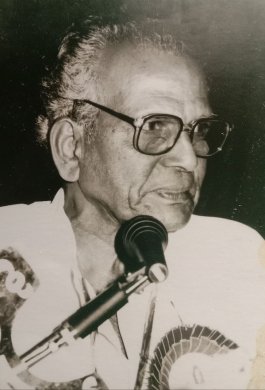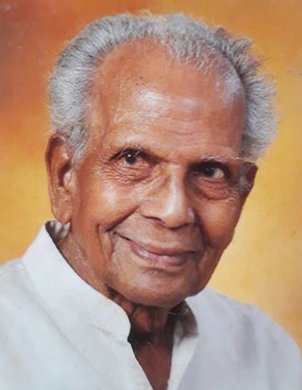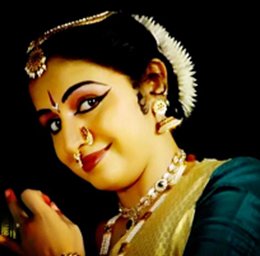 |
  |
 |
  |
Natyacharya K. Muralidhar Rao - Dr. Shrividya Muralidhar e-mail: shrividya.muralidhar@gmail.com July 17, 2021 It is an honour to reminisce about the late Natyacharya K. Muralidhar Rao, whose 98th birthday is on August 2nd. He was like a Kala Muni of the 20th century. His entire life covering ninety decades was dedicated in pursuit of drawing, music, dance, photography and writing articles. A life unequivocally dedicated to art alone! Being the last disciple of the veteran artiste, the life of my Guru is a biopic he orated and made me visualize. This is my humble effort to recollect his meritorious life. After completing his matriculation exam successfully, pursuit of arts became the goal and matrix of his life. Palettes in his left hand and artistry in the right did not go hand in hand when his family did not relish his inclination. They knew it would not fetch him an earning for a living. His domestic situation challenged his artistic vocation. Retorting was no solution. The young adult left his family and home at Kasaragod and moved to Madras to earn his livelihood. He joined as a typist in Government service in Madras and later worked as a clerk in Mangalore for few years which was an unproductive part of his life.  A restless desire backed up by the zest to achieve something big, propelled his dream to reach Bombay. The commercial capital of India beckoned Kasaragod Muralidhar Rao. He roamed for months in the streets of Bombay, seeking shelter beside the bushes of the parks. A single bun a day became the daily bread of the wandering artist. Long stories of pathetic events unfolded when he narrated his past. However, a part time job at Kuldeep Pictures as an assistant photographer marked the beginning of his artistic career. Once into the film industry, he embarked into the art of drawing posters of reel life into real life. The year 1950 is hailed as the annus mirabilis marking the renaissance of Hindi cinema. The dance, drama, and music he witnessed everyday at his workplace enticed him to act in a drama where he met the renowned Kathakali artiste Rajan Ayer whose charismatic presence made an immense impact on him. Unfortunately due to ill health and other personal issues, Muralidhar was forced to leave Bombay. He decided to undertake a new odyssey towards Kerala to take up Kathakali under the tutelage of the doyen Rajan Ayer. As a young Kathakali artiste, he performed in more than 200 Kathakali stage shows all over Karnataka then. It was considered as a new genre in dance for the audience of Karnataka. Bharatanatyam is an art which requires vivacious cognizance. Muralidhar was lured by this dance genre, when he watched the dance recital of Rajaratnam Pillai of Salem. The rhythms in the mind and beauty of movement intertwined at heart, Murali took a U-turn to Chennai where he learnt the Pandanallur style of Bharatanatyam from gurus Rajaratnam Pillai and Chokalingam Pillai. Nurtured into a full-fledged artist, at the age of 47 he secured first rank in the Vidwath Bharatanatyam exam conducted by the State Board. Later on, officially he set into performing recitals, organizing stages, traveling for dance, researching, writing dance related articles, struggled and worked hard harbouring the aspiration to become a Bharatanatyam guru himself. A torchbearer of the Pandanallur dance style through his dance school Nrityaksharam, he envisaged his shishyas to comprehend the knowledge from the Natyashastra. Karnataka Kala Tilaka, Natyarani Shanthala Prashasti, Rajyothsava Prashasti are some of the prestigious awards conferred upon him by the Government of Karnataka. For his erudite commitment to art, titles, awards, felicitations poured in. But he shied away from popularity because it meant nothing to the silent achiever. His idea was to create dancers who were creators themselves and not imitators of his legacy. Guru Muralidhar was an artist who strayed into the world of dance, captured the art world by his inimitable choreography and creations. His choreographies were original works of art instilled with a lifelike flow of creativity. The class rasika (not ecclesiastical) and the mass with earnest interest, explored the soul of his creative ingenuity. A beacon to the Guru-Shishya Parampara, he detested dance class factories, where hundreds of pupils learn simultaneously. Instead, he handpicked students, taught them solo, choreographed items, sculpted it in the pupil's angaharas. Each individual shishya with her body kinetics, facial bhavas, literary interest, dedication, grasping ability and patience to delve deeper into scripts, kindled Guru Muralidhar to envisage and lead her towards perfection. He was a dedicated teacher who taught meticulously. Time was never a constraint to him. Any shishya undertaking class patiently, danced for 6 to 8 hours at a stretch. It was not just dancing but sessions, which made the student think, why and how, dance is structured and shaped. Notched up to his credit, is the concept of manodharma in the repertoires. A literati himself, he stood as a torch bearer to his students to comprehend the lyrics of the repertoire in different angles. Dealing with layers, overt and covert of the texts, he explored through angaja and mukhaja abhinayas eloquently. Ideas welled up in his mind and as such, to the poetries of Margam, he gave substance and style. The whole point was exploring the beauty of poesy through manodharma and angaharas to lead the presentation towards aesthetic delight of the rasika.  Like an Indian sculpture coming alive into dance, he sketched an elegant dancer on the canvas. An ordinary girl got artistically chiseled in his hands to become a sensible and intellectual dancer. He propounded that every stage presentation was an examination to the artist. For him, preparing his shishya for a stage show was like sitting with an empty canvas upon which pictures erupted lifelike with celebrative and festive colors. Juxtaposing, the dancer enacted stories, induced emotions, expressed attachments lifelike and petered out the show, leading to catharsis. The aesthetic delight was experienced by both the performer as well as her audience definitely in different ways. Wedded to the art of drawing, he fell in love with dance. He dexterously managed the two sides of art in his life; he found no time to marry and promote a family. Couched in the comfort of a bachelor's life, he was a lover of peace and privacy. He was unaware of the worldly affairs, policies, possessions, money making etc. His life was a meditation of Art and dance - a worship. Art for art's sake was his ideology. Hence he was not adamant to make his art current, viable, valid, relevant or easily accessible. He repeatedly said, "Do not stoop down to the taste of the masses, and instead elevate them through your art." The 'Bharatanatyam' to 'Bharatanrityam' transition was the result of his experiences and realizations while delving into the art. To him, as a Kathakali performer, the term 'Natya' is justified in only this dance form. Coming to Bharatanatyam, his abhinaya choreographies are unique. He believed 'Nritya' is a subject of infinite research which will make the dance form a timeless classic. 'Bharatanrityam' is the term synonym to the ekaaharya dance done in Bharatanatyam he felt. Bharatanrityam as he adhered, being a precious carryover of the past, we must protect and preserve it not in its repeated mundane form, but in a creatively relevant form, understandable and appreciable today. In short, his works were the contemporary response to tradition. Nritya was the subject of his research. The reservoir of literature in the Nritya got excavated in his hands in multifarious modes. No doubt he was a repository of knowledge - a mobile dance dictionary, as dance teachers and aspirants named him. His book Nrithyaloka, a theoretical treatise on 'Bharatanrityam,' was the first of its authentic kind, written in Kannada in 1996. He toured with his troupe and French disciple Manochhaya Katia Légeret, all over Europe several times, giving performances along with a talk about Indian classical dance in German radio. Guru Muralidhar Rao's life is an open book of experiences that speak volumes. Most prima donnas of the dance form have at one time or other in their lives come under the guidance and tutelage of the great Guru. He also served as a chief resource advisor for text books of 'Bharatanatyam' published by the Government of Karnataka for several years. Literally and figuratively tall in the dance field, he was 94 and it was on May 1, 2017 he left his mortal body. All his life he unearthed the beauty of art, reading literature, sketching and drawing for books, teaching Bharatanrityam, authoring a book on dance and photography. He lived a rich and blessed life as an artiste and led the life of plain living and high thinking. Unsung he lived and unsung he died. His entire life is an immense and ennobling archive of the life of artistic and spiritual adventures disseminating the highest truth that through Art one can attain liberation.  A PhD holder in Bharatanatyam, Dr. Shrividya Muralidhar is a performer who is into dance research. For the past 3 decades, she is the Artistic Director of her school Sourabha Kala Parishath in Mangalore. Post your comments Please provide your name and email id along with your comment. All appropriate comments posted with name and email id in the blog will also be featured in the site. |